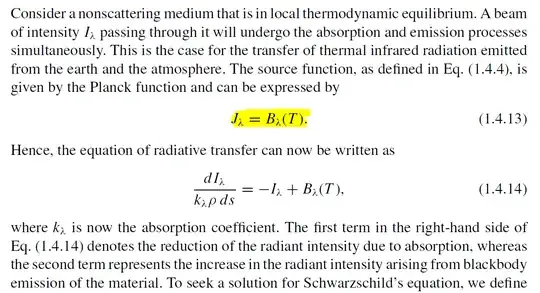Can a parcel of gas with large value of optical thickness really radiate like a black body? I have in mind a simple (most likely oversimplified) model which yields
$$I_\nu = I_\nu(0) e^{-\tau\nu} + I_\nu^B [1-e^{-\tau_\nu}]$$
It says, that radiation of a layer of optical thickness $\tau$ radiates based on
- the radiation entering on one side, attenuated by absorption
- the intrinsic radiation, also attenuated by absorption
I have seen this equation in several books. But I do not understand the quantity $J_\nu$ in the equation
$$d I\lambda = -k_\lambda \rho I_\lambda ds + j_\lambda \rho ds$$
which is replaced after introducing the source function $J_\lambda=j_\lambda/k_\lambda$ by
$$\frac{d I\lambda(s)}{k_\lambda \rho ds} = -I_\lambda(s) + J_\lambda(s)$$
In my textbook, a few sentences after having introduced this, it is said, that
$$J_\lambda(s) = B_\lambda^B(T)$$
where $B_\lambda^B(T)$ is the Planck-Function. I cannot follow this argument: It would mean, that an absorbing gas with sufficiently big optical thickness radiates to the outside according to Planck's law - but by what argument this assumption is justified?
See here the original text:
